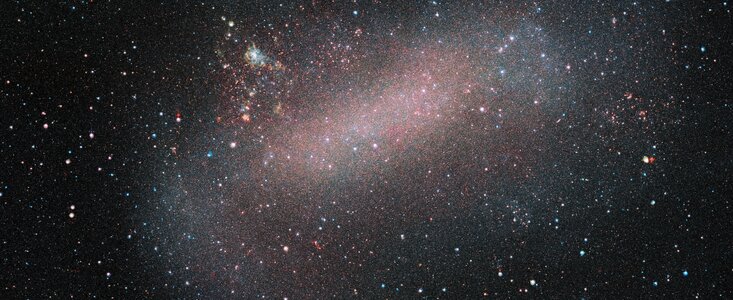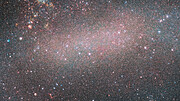Persbericht
VISTA onthult een nieuw beeld van de Grote Magelhaense Wolk
13 september 2019
ESO’s VISTA-telescoop geeft een opmerkelijk beeld van de Grote Magelhaense Wolk, een van onze meest nabije galactische buren. VISTA heeft dit sterrenstelsel en diens broertje, de Kleine Magelhaense Wolk, en hun omgeving ongekend gedetailleerd in kaart gebracht. Deze survey stelt astronomen in staat om een groot aantal sterren te bekijken, wat nieuwe mogelijkheden oplevert om de evolutie van sterren, de dynamica van sterrenstelsels en veranderlijke sterren te onderzoeken.
De Grote Magelhaense Wolk(GMW) is met een afstand van slechts 163.000 lichtjaar een van onze naaste galactische buren. Hij en zijn broertje, de Kleine Magelhaense Wolk, behoren ook tot de dichtstbijzijnde dwergsterrenstelsels van de Melkweg. De GMW is tevens de thuisbasis van verschillende stellaire conglomeraten en een ideaal astronomisch ‘laboratorium’ om de processen te onderzoeken die sterrenstelsels vormgeven.
ESO’s VISTA-telescoop heeft deze twee sterrenstelsels het afgelopen decennium waargenomen. De opname die vandaag wordt gepresenteerd, is het resultaat van een van de vele surveysdie astronomen met deze telescoop hebben uitgevoerd. Het hoofddoel van de VISTA Magellanic Clouds (VMC) Survey was het in kaart brengen van de stervormingsgeschiedenis en de driedimensionale structuren van de beideMagelhaenseWolken.
VISTA was cruciaal voor het maken van deze foto, omdat deze de hemel waarneemt op nabij-infrarode golflengten. Hierdoor kan hij door de stofwolken heen kijken die delen van het sterrenstelsel aan het zicht onttrekken. Deze wolken houden een groot deel van het zichtbare licht tegen, maar zijn transparant bij de langere golflengten waarop VISTA de hemel waarneemt. Als gevolg hiervan zijn veel meer van de sterren die het hart van dit sterrenstelsel bevolken duidelijk zichtbaar. Astronomen hebben ongeveer 10 miljoen afzonderlijke sterren in de Grote Magelhaense Wolk nauwkeurig onderzochten en met behulp van geavanceerde stermodellenhun leeftijden bepaald [1]. Daarbij hebben ze ontdekt dat jongere sterren meerdere spiraalarmen in dit sterrenstelsel markeren.
Mensen op het zuidelijk halfrond kijken al duizenden jaren geboeid naar de Magelhaense Wolken, maar in Europa waren ze tot de tijd van de ontdekkingsreizen vrijwel onbekend. De namen die we nu voor beide sterrenstelsels gebruiken verwijzen naar deontdekkingsreiziger Ferdinand Magelhaen, die 500 jaar geleden de eerste zeereis rond de aarde leidde. In de logboeken die de expeditie terug naar Europa bracht, werden veel plaatsen en zaken genoemd waar Europeanen nog nooit van hadden gehoord. De geest van onderzoek en ontdekking komt tegenwoordig steeds opnieuw tot leven in het werk van astronomen over de hele wereld, waaronder het VMC-team wiens waarnemingen hebben geleid tot deze verbluffende foto van de Grote Magelhaense Wolk.
Noten
[1] Stermodellen stellen astronomen in staat om leven en dood van sterren te voorspellen en geven op die manier inzicht in stellaire eigenschappen zoals leeftijd, massa en temperatuur.
Meer informatie
De sterren die op deze foto zijn ontdekt worden besproken in het artikel ‘The VMC Survey - XXXIV. Morphology of Stellar Populations in the Magellanic Clouds’, dat in het tijdschrift Monthly Notices of the Royal Astronomical Societyzal verschijnen.
ESO is de belangrijkste intergouvernementele astronomische organisatie in Europa en verreweg de meest productieve sterrenwacht ter wereld. Zij wordt ondersteund door zestien lidstaten: België, Denemarken, Duitsland, Finland, Frankrijk, Ierland, Italië, Nederland, Oostenrijk, Polen, Portugal, Spanje, Tsjechië, het Verenigd Koninkrijk, Zweden en Zwitserland, en door gastland Chili en strategisch partner Australië. ESO voert een ambitieus programma uit, gericht op het ontwerpen, bouwen en beheren van grote sterrenwachten die astronomen in staat stellen om belangrijke wetenschappelijke ontdekkingen te doen. Ook speelt ESO een leidende rol bij het bevorderen en organiseren van samenwerking op astronomisch gebied. ESO beheert drie waarnemingslocaties van wereldklasse in Chili: La Silla, Paranal en Chajnantor. Op Paranal staan ESO’s Very Large Telescope (VLT) en haar toonaangevende Very Large Telescope Interferometer, evenals twee surveytelescopen – VISTA, die in het infrarood werkt, en de op zichtbare golflengten opererende VLT Survey Telescope. ESO speelt tevens een belangrijke partnerrol bij twee faciliteiten op Chajnantor, APEX en ALMA, het grootste astronomische project van dit moment. En op Cerro Armazones, nabij Paranal, bouwt ESO de 39-meter Extremely Large Telescope, de ELT, die ‘het grootste oog op de hemel’ ter wereld zal worden.
Links
Contact
Maria-Rosa Cioni
Leibniz-Institut für Astrophysik Potsdam (AIP)
Potsdam, Germany
Tel: +49 331 7499 651
E-mail: mcioni@aip.de
Mariya Lyubenova
ESO Head of Media Relations
Garching bei München, Germany
Tel: +49 89 3200 6188
E-mail: pio@eso.org
Marieke Baan (Perscontact Nederland)
ESO Science Outreach Network
en NOVA Informatie Centrum
Tel: +31(0)20-5257480
E-mail: eson-netherlands@eso.org
Over dit bericht
| Persberichten nr.: | eso1914nl |
| Naam: | Large Magellanic Cloud |
| Type: | Local Universe : Galaxy : Type : Irregular |
| Facility: | Visible and Infrared Survey Telescope for Astronomy |
| Instruments: | VIRCAM |
| Science data: | 2019MNRAS.490.1076E |
Our use of Cookies
We use cookies that are essential for accessing our websites and using our services. We also use cookies to analyse, measure and improve our websites’ performance, to enable content sharing via social media and to display media content hosted on third-party platforms.
ESO Cookies Policy
The European Organisation for Astronomical Research in the Southern Hemisphere (ESO) is the pre-eminent intergovernmental science and technology organisation in astronomy. It carries out an ambitious programme focused on the design, construction and operation of powerful ground-based observing facilities for astronomy.
This Cookies Policy is intended to provide clarity by outlining the cookies used on the ESO public websites, their functions, the options you have for controlling them, and the ways you can contact us for additional details.
What are cookies?
Cookies are small pieces of data stored on your device by websites you visit. They serve various purposes, such as remembering login credentials and preferences and enhance your browsing experience.
Categories of cookies we use
Essential cookies (always active): These cookies are strictly necessary for the proper functioning of our website. Without these cookies, the website cannot operate correctly, and certain services, such as logging in or accessing secure areas, may not be available; because they are essential for the website’s operation, they cannot be disabled.
Functional Cookies: These cookies enhance your browsing experience by enabling additional features and personalization, such as remembering your preferences and settings. While not strictly necessary for the website to function, they improve usability and convenience; these cookies are only placed if you provide your consent.
Analytics cookies: These cookies collect information about how visitors interact with our website, such as which pages are visited most often and how users navigate the site. This data helps us improve website performance, optimize content, and enhance the user experience; these cookies are only placed if you provide your consent. We use the following analytics cookies.
Matomo Cookies:
This website uses Matomo (formerly Piwik), an open source software which enables the statistical analysis of website visits. Matomo uses cookies (text files) which are saved on your computer and which allow us to analyze how you use our website. The website user information generated by the cookies will only be saved on the servers of our IT Department. We use this information to analyze www.eso.org visits and to prepare reports on website activities. These data will not be disclosed to third parties.
On behalf of ESO, Matomo will use this information for the purpose of evaluating your use of the website, compiling reports on website activity and providing other services relating to website activity and internet usage.
Matomo cookies settings:
Additional Third-party cookies on ESO websites: some of our pages display content from external providers, e.g. YouTube.
Such third-party services are outside of ESO control and may, at any time, change their terms of service, use of cookies, etc.
YouTube: Some videos on the ESO website are embedded from ESO’s official YouTube channel. We have enabled YouTube’s privacy-enhanced mode, meaning that no cookies are set unless the user actively clicks on the video to play it. Additionally, in this mode, YouTube does not store any personally identifiable cookie data for embedded video playbacks. For more details, please refer to YouTube’s embedding videos information page.
Cookies can also be classified based on the following elements.
Regarding the domain, there are:
- First-party cookies, set by the website you are currently visiting. They are stored by the same domain that you are browsing and are used to enhance your experience on that site;
- Third-party cookies, set by a domain other than the one you are currently visiting.
As for their duration, cookies can be:
- Browser-session cookies, which are deleted when the user closes the browser;
- Stored cookies, which stay on the user's device for a predetermined period of time.
How to manage cookies
Cookie settings: You can modify your cookie choices for the ESO webpages at any time by clicking on the link Cookie settings at the bottom of any page.
In your browser: If you wish to delete cookies or instruct your browser to delete or block cookies by default, please visit the help pages of your browser:
Please be aware that if you delete or decline cookies, certain functionalities of our website may be not be available and your browsing experience may be affected.
You can set most browsers to prevent any cookies being placed on your device, but you may then have to manually adjust some preferences every time you visit a site/page. And some services and functionalities may not work properly at all (e.g. profile logging-in, shop check out).
Updates to the ESO Cookies Policy
The ESO Cookies Policy may be subject to future updates, which will be made available on this page.
Additional information
For any queries related to cookies, please contact: pdprATesoDOTorg.
As ESO public webpages are managed by our Department of Communication, your questions will be dealt with the support of the said Department.








